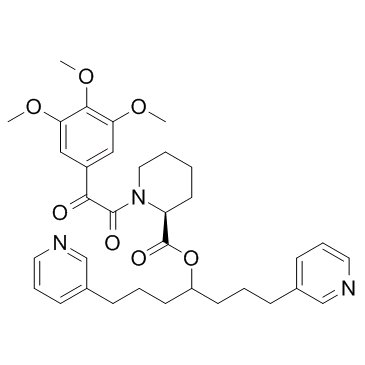Biricodar (VX-710) (Synonyms: VX-710) |
| Catalog No.GC33338 |
Biricodar (VX-710) (VX-710) is a modulator of P-glycoprotein and MRP-1; shows effective chemosensitizing activity in multidrug resistant cells.
Products are for research use only. Not for human use. We do not sell to patients.

Cas No.: 159997-94-1
Sample solution is provided at 25 µL, 10mM.
Biricodar (VX-710) is a modulator of P-glycoprotein and MRP-1; shows effective chemosensitizing activity in multidrug resistant cells.
Biricodar shows activity against both P-glycoprotein (Pgp) and MRP-1 and also has activity in increasing drug uptake and retention and reversing drug resistance mediated by wild-type BCRP (BCRPR482). In 8226/Dox6 cells (Pgp), biricodar increases mitoxantrone and daunorubicin uptake by 55 and 100%, respectively, increases their retention by 100 and 60%, respectively, and increases their cytotoxicity 3.1- and 6.9-fold, respectively. Biricodar also increases the uptake, retention and cytotoxicity in HL60/Adr (MRP-1) and 8226/MR20 cells (BCRP(R482)), but has little effect in MCF7 AdVP3000 cells (BCRP(R482T))[1]. VX-710 is a non-macrocyclic pipecolinate derivative which binds the FK506 receptor protein. VX-710 has been shown to restore sensitivity in a range of multidrug-resistant cells, including myeloma, melanoma, carcinoma and leukaemia[2]. Biricodar effectively inhibits photoaffinity labeling of P-glycoprotein by [3H]azidopine or [125I]iodoaryl azido-prazosin with EC50 values of 0.75 and 0.55 μM[3].
[1]. Minderman H, et al. VX-710 (biricodar) increases drug retention and enhances chemosensitivity in resistant cells overexpressing P-glycoprotein, multidrug resistance protein, and breast cancer resistance protein. Clin Cancer Res. 2004 Mar 1;10(5):1826-34. [2]. Yanagisawa T, et al. BIRICODAR (VX-710; Incel): an effective chemosensitizer in neuroblastoma. Br J Cancer. 1999 Jun;80(8):1190-6. [3]. Germann UA, et al. Cellular and biochemical characterization of VX-710 as a chemosensitizer: reversal of P-glycoprotein-mediated multidrug resistance in vitro. Anticancer Drugs. 1997 Feb;8(2):125-40.
Average Rating: 5 (Based on Reviews and 9 reference(s) in Google Scholar.)
GLPBIO products are for RESEARCH USE ONLY. Please make sure your review or question is research based.
Required fields are marked with *




















